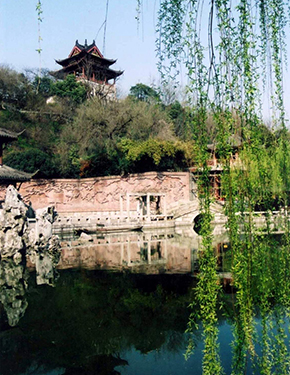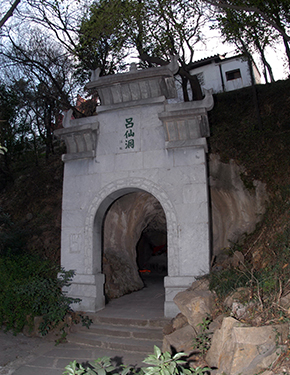
Pavilion of Celestial Fei Yi
- Nomal
- Enlarge
- Reduce
In the spring of 1993, it was built according to the tale that Fei Yi came here on craneback and took a rest. From then onwards, the pavilion has nestled within the Northern Section, 70 m or so northeast of Yellow Crane Tower and 214 m west of north of White Cloud Pavilion. And it is just 8 m or so from the gate of Cave of Immortal Lü.
Fei Yi (?-253), styled Wenwei, was a native of Jiangxia County (now northeast of Xinyang, Henan). When his parents died, he was still very young and adopted by his uncle Boren. Later he wandered to Yizhou (Sichuan) for furthering studies. At that time, Liu Bei pacified Yizhou and Fei attached himself to Liu Bei. It follows that he became Secretarial Receptionist of Crown Prince. Later when Liu Shan ascended the throne, he was promoted to Gentleman Attendant at the Palace Gate and admired by Zhuge Liang. He replaced Jiang Wan as Military Advisor and Administration Minister. Fei thus possessed authority over military and political affairs. To join hands with Wu against Wei, he visited Eastern Wu and persuaded ruler Sun Quan to do so. Fei Yi, Zhuge Liang, Jiang Wan and Dong Yun were “Four Luminaries” on the lips of Shu’s people. In Chen Shou’s The Records of Three Kingdoms, Fei Yi got stabbed by Guo Xun, a traitor who defected to Wei, in the 16th Year (253) of Yanxi Period.
Such record first emerged in Records of Yellow Crane Tower by Yan Boli in the 1st Year (765) of Tang’s Yongtai Period. Yan quotes Topographical Classic in that gazetteer, “After attaining immortalhood, Fei Yi ever returned here riding a yellow crane. The pavilion was named after this anecdote.” As a result, even Gazetteer of the World during the Taiping Period adopted this influential statement, “Yellow Crane Tower is 280 steps west of the county seat. In the past, Fei Yi often visited here when he had become immortal. That is why the pavilion is given this name.” This tale evolved too with the elapse of time. As the immortal was Zi’an in The Book of Southern Qi, Fei Yi and Zi’an became one person and the plot of crane riding got aggrandized. Especially in Ming Era, such tales spread far and wide. Wang Shizhen’s Complete Life Stories of Immortals, for example, recorded, “Fei Yi, styled Zi’an, loved Taoism and attained immortalhood. Once a time, he came across Xin’s tavern and drank to his heart’s content. Later he took another drink with a mug. Next day he directly drank without asking for wine. This continued for several years. During the period, Xin always treated him generously. Fei told Xin, ‘I owed you a lot of money. Now I return you more or less.’ Then he fetched some orange peel and painted a crane with the peel. Instantly, the crane came alive and began to dance. Fei himself took out a flute and played a tuneful melody. This attracted all guests far and near. More than a decade later, Xin had got over 10,000 taels of silver. One day, Zi’an came and asked, ‘How much was my return worth?’ Xin thanked him, ‘It is the crane you painted has made me gain money more than 100 times. Please stay for a while and let me thank you anyway.’ Zi’an smiled, ‘Why are you so formal?’ He took out his flute and played it several times. Shortly afterwards, white clouds fell from midair and the crane flew to Zi’an. Then Zi’an rode the crane and flew away. Xin erected a tower on the site and named it Yellow Crane Tower.”
Fei Yi was often artfully related with Yellow Crane Tower. From Tang onwards, Cave of Fei Yi and Shrine of Minister Fei emerged beside that tower. Tang poet Li Zongmeng sighed in Shrine of Minister Fei, “Only the relic site of Celestial Fei remains intact; all this land is steeped in deep sorrow.” Yet some researchers attested that such tales are unauthentic quoting various sources.
The tale of Fei Yi may be originated from the crane-riding immortal in Records of Strange Tales. That immortal was recorded to be Xun Gui styled Shuwei. And Fei Yi had a style name “Wenwei.” In that era, it was easy to confuse Shuwei with Wenwei as the former was more familiar to common people, in particular locals. The immortal riding a crane became Fei Yi over time.
The pavilion rebuilt in the north in 1993 stands opposite to Cave of Immortal Lü.

Tourist Service
- consulting hotline
Service hotline: 027-88875096
Supervision hotline: 027-88848188
027-12301
(Wuhan Tourism Bureau.)
027-87124701
(Hubei Tourism Administration)
- Official qr code.

Scan focuses on the yellow crane tower.
- Online consultant
- Complaint and advice






